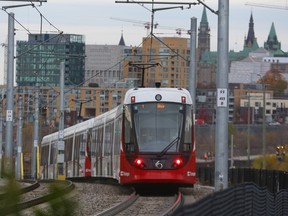A study by Ontario’s Financial Accountability Office says Ottawa will see the steepest decline of anywhere in the province next year in per-resident subsidies for transit.

Article content
For the City of Ottawa, which already complains it doesn’t get its fair share of transit funding from the province, things are about to get worse.
A study released this past week by Ontario’s Financial Accountability Office says Ottawa will see the steepest decline of anywhere in the province next year in per-resident subsidies for transit. The reasons? Declining gas tax revenue and the end of special post-pandemic “Safe Restart” funding.
Advertisement 2
Story continues below
Article content
Ottawa will be the hardest hit of five regions where subsidies will decline in 2024-25, the report shows.
“The FAO projects that the Ottawa economic region will experience the largest reduction in per-resident subsidies, from $59.61 in 2022-23 to $31.91 in 2024-25, primarily due to the conclusion of the Safe Restart Agreement,” says the report that was released on Thursday.
Windsor-Sarnia, London, Stratford-Bruce Peninsula, and Kingston-Pembroke are the other regions hit by the reductions.
In contrast, the per-resident subsidy in Toronto will rise to $196.49 in 2024-25 from $191 in 2022-23, the report says, largely because of heavy subsidies provided to the regional carrier, Metrolinx, which serves commuters in Toronto and the entire Golden Horseshoe area.
The greatest increases in per-resident subsidies will occur in the province’s far northwest and northeast, areas served by the regional Ontario Northland service.
The average per-person subsidy across the province was $111.16, a number dragged upward by the Toronto effect. Ottawa’s per-resident subsidy of $59.61 was comparable to the $59.82 figure in the Hamilton-Niagara region and significantly higher than Kitchener-Waterloo-Barrie ($36.76) and Kingston-Pembroke ($19.29).
Article content
Advertisement 3
Story continues below
Article content
The Toronto Transit Commission sits head and shoulders above other transit networks when it comes to provincial operation subsidies, but it is also by far the biggest and busiest.
The TTC serves a population of 3.0 million compared to 1.1 million in Ottawa, yet TTC had a ridership of 321 million in 2022 (the most recent ridership numbers used in the report). That’s more than six times greater than OC Transpo’s 50.8 million riders that same year.
Both the TTC and OC Transpo were hit hard by the COVID-19 pandemic and the work-from-home and hybrid-work models that came with it.
TTC ridership declined by 330 million (62.4 per cent) between 2019 and 2021, but rebounded to 60.6 per cent of pre-pandemic levels by 2022, the report says.

OC Transpo’s ridership dropped by 66.3 million rides (67.4 per cent) from 2019 to 2021, but only returned to 51.7 per cent of pre-pandemic levels by 2022.
Ottawa is last in Ontario when it comes to generating its own transit revenue. Just 19 per cent of OC Transpo’s operating revenue came from fares, with the remaining 81 per cent coming from provincial and federal subsidies, the FAO says. The TTC, in contrast, generated 35.9 per cent of its revenue from fares and 64.1 per cent from government subsidies. The provincial average of own-source revenue was “about a third,” the FAO reports said.
Advertisement 4
Story continues below
Article content
The FAO report did not look into capital costs, an expenditure that Ottawa Mayor Mark Sutcliffe has repeatedly raised in his “Fairness for Ottawa” campaign.
When Ottawa struck its deal to build the Confederation Line LRT, which celebrated its fifth birthday on Saturday, the cost was to be shared equally, with municipal, provincial and federal governments each paying a third. But constructions costs soared during the pandemic and ongoing and costly reliability problems have ballooned the LRT pricetag. Ottawa taxpayers have borne those increases alone, leaving the city covering nearly half the cost of the $4.6-billion system.

More recent agreements in Toronto have seen the province pay the full cost of expensive subway expansions. The Ontario-Toronto New Deal Agreement announced in November 2023 included a one-time $300-million Subway and Transit Safety, Recovery and Sustainable Operations Fund to the TTC in 2023-24 and another three-year, $330-million Finch West and Eglinton Crosstown LRT operating support subsidy.
In contrast, the New Deal for Ottawa announced by Premier Doug Ford in April included money for a new interchange on Highway 417 at Barnsdale Road and a proposal for the province to assume responsibility for Regional Road 174, but no money earmarked for transit.
Article content
Comments